Soybean futures feed the debate at Ars Electronica
Published 10 September 2019 by Ewen Chardronnet
This year, the Ars Electronica festival celebrated its 40th anniversary in Linz, Austria. Makery was there, and this first report follows discussions around the “Soybean Futures” workshop at Stadtwerkstatt.
Linz (Austria), special report
Stadtwerkstatt (STWST) is a cultural center founded as an artists collective in 1979, which, along with Ars Electronica, is celebrating its 40th anniversary this year. STWST is located across from the Ars Electronica Center, along the Danube, and is a pioneer in the history of independent media since the 1980s with the emergence of the Internet and digital new media. Notable milestones include: its own structure for artistic production; the servus.at initiative, which manages its own cultural data center, creates and presents artworks dedicated to hactivism, open culture and critical engineering; and Radio FRO, a free radio that produces and archives radio programs managed by Austrian citizens. Radio FRO hosted a discussion on hacktivist mailing-lists from the first online wave, such as Nettime, Faces and many others.

Stay Unfinished, tofu day
STWST48x5, the 5th edition of Stadtwerkstatt’s 48-hour nonstop program, organized in collaboration with Ars Electronica, chose as its theme “Stay Unfinished”. While reflecting on the history of cultures represented by the venue over the past decades, Stay Unfinished also claimed the never finished, always evolving status of artistic creation, in order to project itself into the future, tirelessly searching for coalitions between art and social issues, defending the utopia of an open society.
Makery, also present at the inaugural STWST48 event in 2015, was invited this year to present the Feral Labs network – in the frame of the “Unfinished Lab” session organised par Pedro Soler and with Alexander Correa (Platohedro) and Margarete Jahrmann (Ludic Society) – and listen to other talks during the consecutive 48-hours. Here we report on the transversal debates that emerged from the “Soybean Futures” workshop.
On September 7, Stadtwerkstatt hosted a program on the futures of soybeans, organized by Shu Lea Cheang (Taiwan/Paris, co-curator of STWST48x5, and whose work we covered recently) and Dimension Plus, a new media creative team founded by Escher Tsai (Taiwan) and Keith Lam (Hong Kong) in 2009. The program included a DIY workshop to make tofu, a debate on the geopolitics of soya, an outdoor sound performance on the shared open deck between Stadtwerkstatt and the Ars Electronica Center.
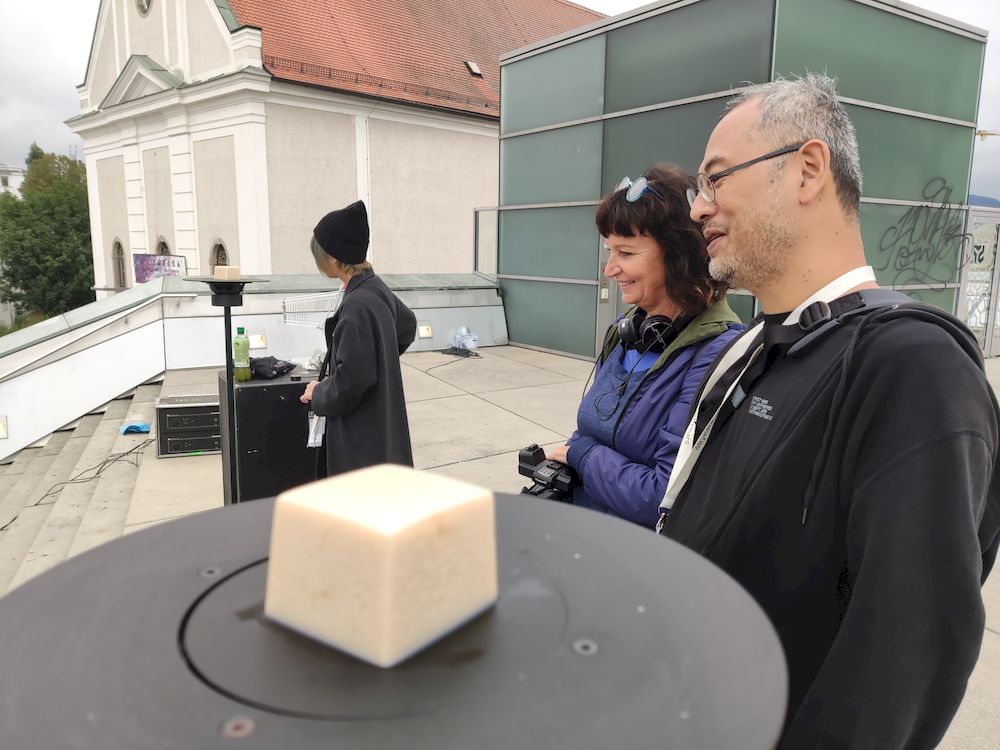
The concept of the sound performance was to vibrate blocks of tofu to the rhythm of data flows on the global soya market. Escher Tsai explained: “The idea for the sound performance came to me a long time ago, but I thought it was relevant to realize it now and to raise the topic of the current trade war around soya.” Dimension Plus combines historical data on the soya market from 1990 to 2019, data on the trade war with China from 2017 to 2019, and real-time market data. Converting all this trading data (Yu-Tung Hsiao, Seth Hon) to soundwaves (Seth Hon, Weiwei Huang), the installation comprises several pieces of white tofu quivering on a simple black plate, recalling algorithmically calculable conflicts and turbulences.
View this post on InstagramA post shared by Makery France (@makeryfr) on
After making DIY tofu from soy milk with Jess Huang, the produce was cooked in the STWST48x5 foodlab and served during a debate moderated by Manray Hsu, Taiwanese independent curator and critic based in Berlin, focusing on the cultural conditions of globalization, relationships between esthetics and politics, and geopolitical situations of contemporary art. Manray Hsu is also currently developing the “Herbal Urbanism” program at the OK Center for Contemporary Art in Linz for Future City 2022. Several artists participated in the talk, including Julian Stadon from Teleagriculture and Lynne DeSilva-Johnson and Margaretha Haughwout from Apriori, also guests of STWST48x5.
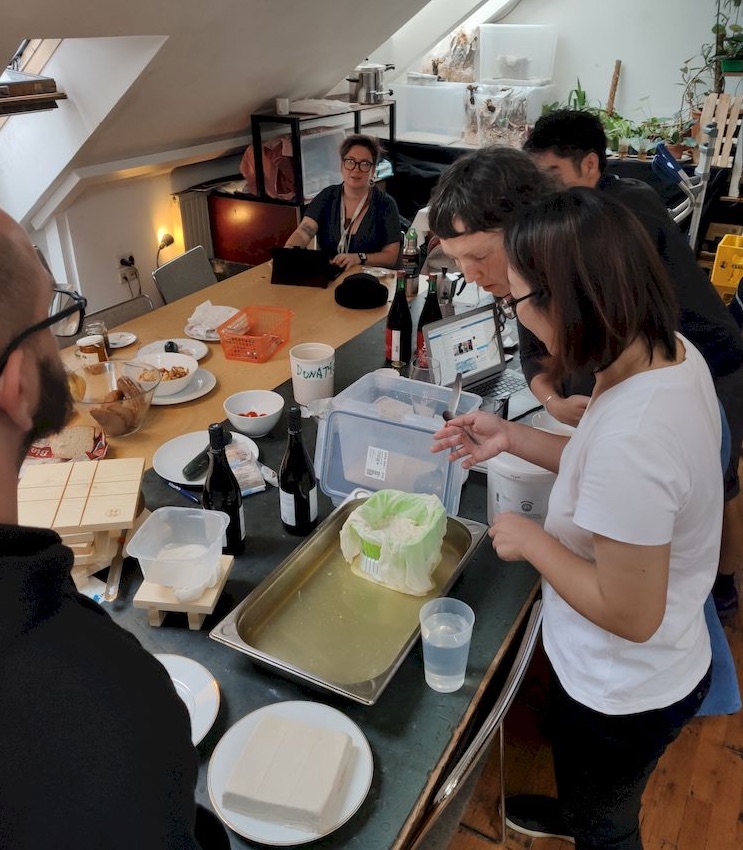

Soya wars
The conversation began around soybeans as an important source of food and protein, as well as a cultural symbol in East Asia. However, Escher Tsai reminded us that “Globalization has transformed the demand for soya into an exchange currency and a weapon in the global trade war.” Then we talked numbers.
According to a June 2019 report by Greenpeace France, for the past 20 years soya production has been increasing drastically, as the increase in imports by the European Union has stimulated the expansion of soya agriculture around the world: “In 1997, 144 million tonnes of soya were produced worldwide; 20 years later production had more than doubled, reaching 353 million tonnes. Since 1998, the top three producer countries have remained the same: the United States is the largest producer, followed by Brazil and Argentina.” The report continues: “After China, the European Union is the world’s second largest soya importer, with around 33 million tonnes of soya products imported per year. This is driven by the EU’s industrial livestock sector: approximately 87% of the soya used in the EU is for animal feed. […] The rapid expansion of soya production is driving the conversion of forests and other natural ecosystems across South America to vast monocrop farms.”
After the G7 meeting in Biarritz this summer, Emmanuel Macron reminded us that “France is complicit” in deforestation, as the largest European importer and consumer of soy cakes—products derived from industrial oil extraction used as feed for livestock. Approximately 25% comes from Brazil, making this dependence particularly problematic.

Soybean deforestation in the Amazon
In Brazil, soya production has more than quadrupled in the past two decades, but even if soya has so far been directly responsable for only 1.2% of deforestation in the Amazon since the moratorium signed in July 2008 and extended indefinitely in 2016—in the past few years soya agriculture has mostly developed in the savannahs and forests of Cerrado, which has lost half of its original vegetation, and Gran Chaco, the second largest forest in South America that extends into Argentina, Bolivia and Paraguay—the situation has taken a dire turn since the election of president Jair Bolsonaro, who approves clearing large areas of the Amazon for mining or agro-industries.
The day before our debate, the federal prosecutor from Belém confirmed that on August 10, 70 people had participated in a collective act of arson, organized via WhatsApp, on the “dia de fogo” along route BR 163 that cuts across the state of Pará in the Amazon, also known as the “deforestation front”. The group, created in the city of Novo Progresso, basically consists of agricultural unionists and land grabbers, claiming support from Jair Bolsonaro and the right to deforest.
Sino-Brazilian space cooperation under threat
I continued the conversation at Stadtwerkstatt with Fabiane Borges, another guest of STWST48x5, in charge of an artist residency program at the National Institute for Space Research (INPE) in São José dos Campos. She explained to me that the institute had gone through a crisis in the weeks preceding the “dia de fogo” incident: the director, Ricardo Galvão, resigned under pressure by Jair Bolsonaro and his minister of the environment Ricardo Salles, who had not appreciated Galvão’s publicizing the numbers on rampant deforestation in the spring. News and numbers reported by Le Monde on August 2, 2019: 739 km2 of forest destroyed in May, a 34% increase from the same month last year; 920 km2 in June (+88%); 1864 km2 in July (+212%). Defending INPE’s data and calling the Brazilian president “cowardly and belligerent”, Ricardo Galvão was forced to resign on August 2.

Fabiane Borges also explained that this resignation was part of regular attacks within the common space program between Brazil and China—CBERS (China-Brazil Earth Resource Satellites)—which soon plans to launch an observation satellite over the Amazon forest: the CBERS-4A. Borges believes that in the trade war between China and the United States, Bolsonaro clearly prefers aligning with the latter. The 20-year-old CBERS program assists teledetection systems monitoring forest fires and greenhouse gases, which goes against the combined interests of the U.S. and Brazil in terms of soya production according to Donald Trump and Jair Bolsonaro. This situation is further reinforced by the agreement signed ealier this year for space cooperation between the U.S. and Brazil for U.S. launches from the Alcântara Launch Center located in the northeast of Brazil, which was interpreted as a message aiming to reduce partnerships with China.
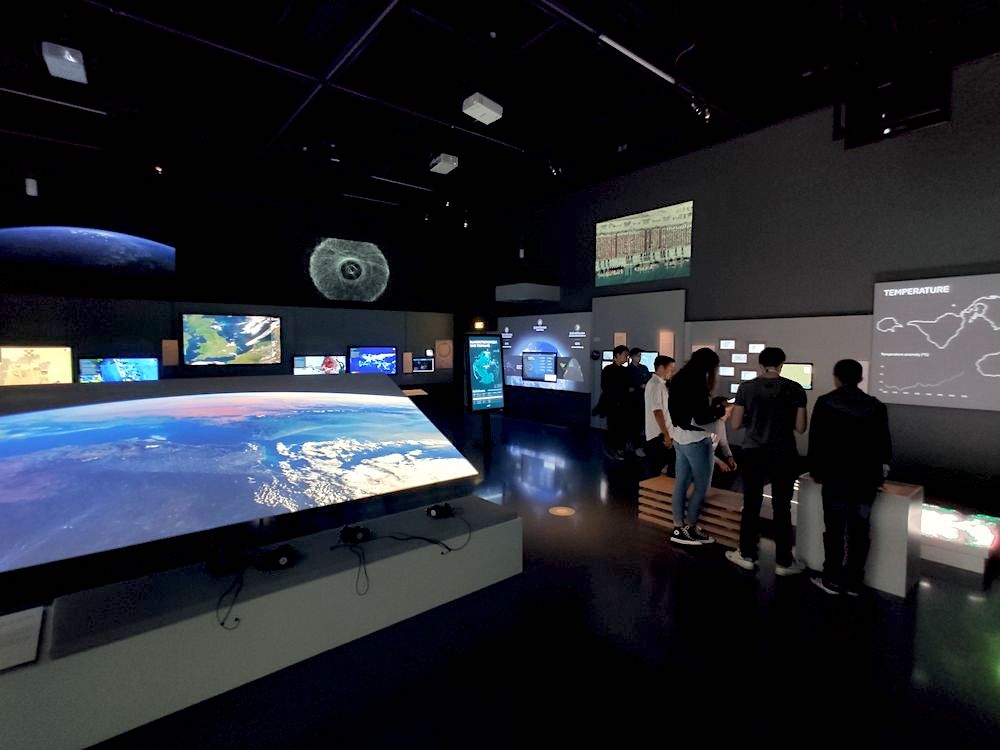
The mission of the CBERS-4A satellite, which will be launched this autumn, is to technologically extend and improve a program whose primary success has been to help Brazil fight deforestation in the Amazon and other vulnerable biomes by providing real-time images of forest fires and other causes. The Sino-Brazilian satellite program provides the authorities with information that can even enable them to catch criminals in the act. Brazil is also scheduled to launch on its own in 2020 the Amazonia-1 satellite to monitor deforestation and increase in agriculture, assuming that the program will not be compromised by the country’s current administration.
After these enlightening conversations, workshop participants went outside to listen to the sound performance by Dimension Plus.
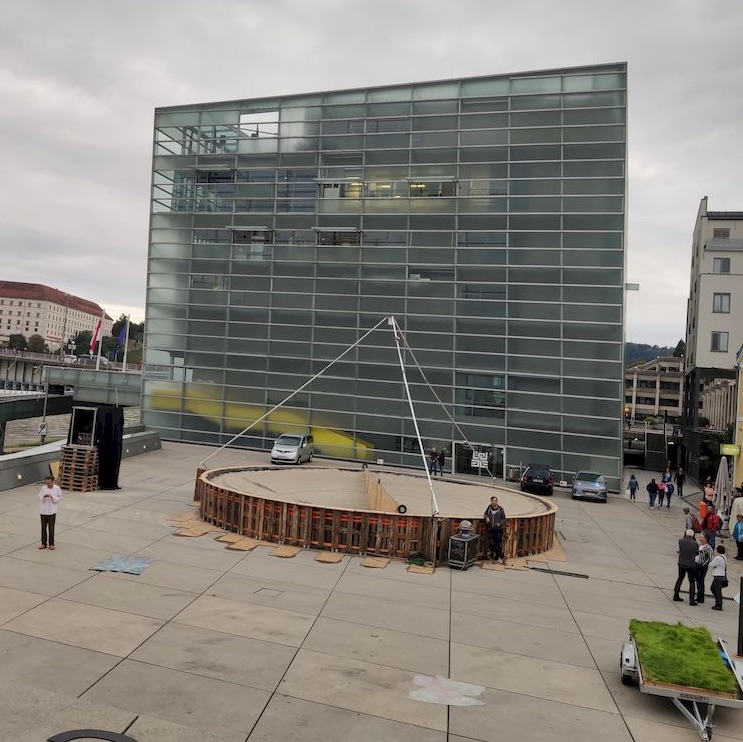
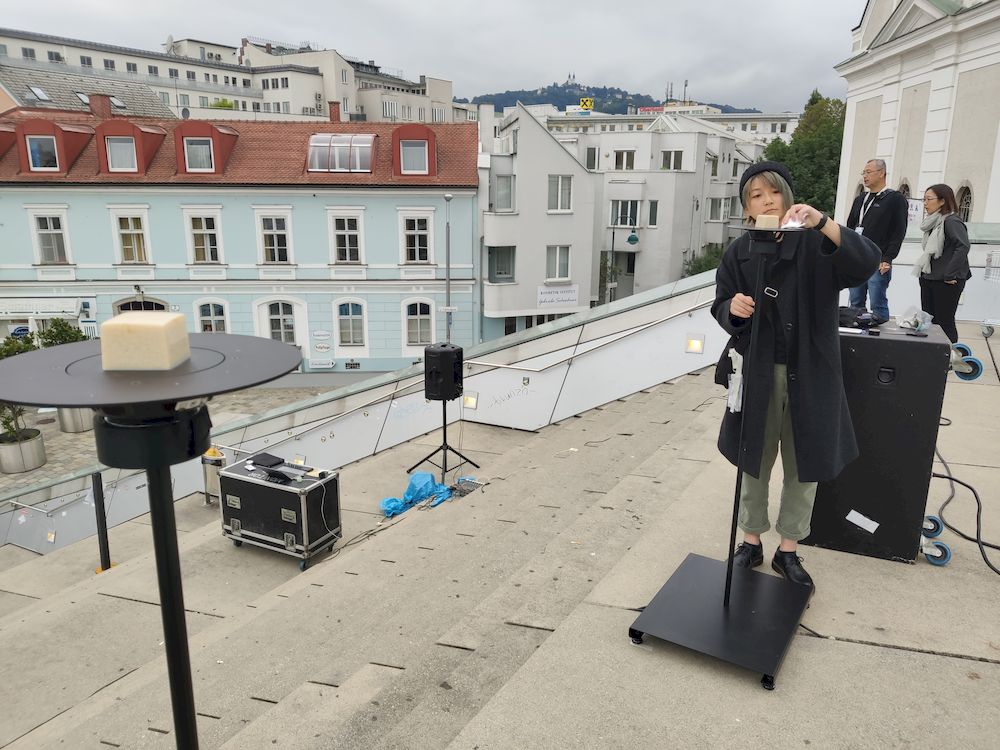

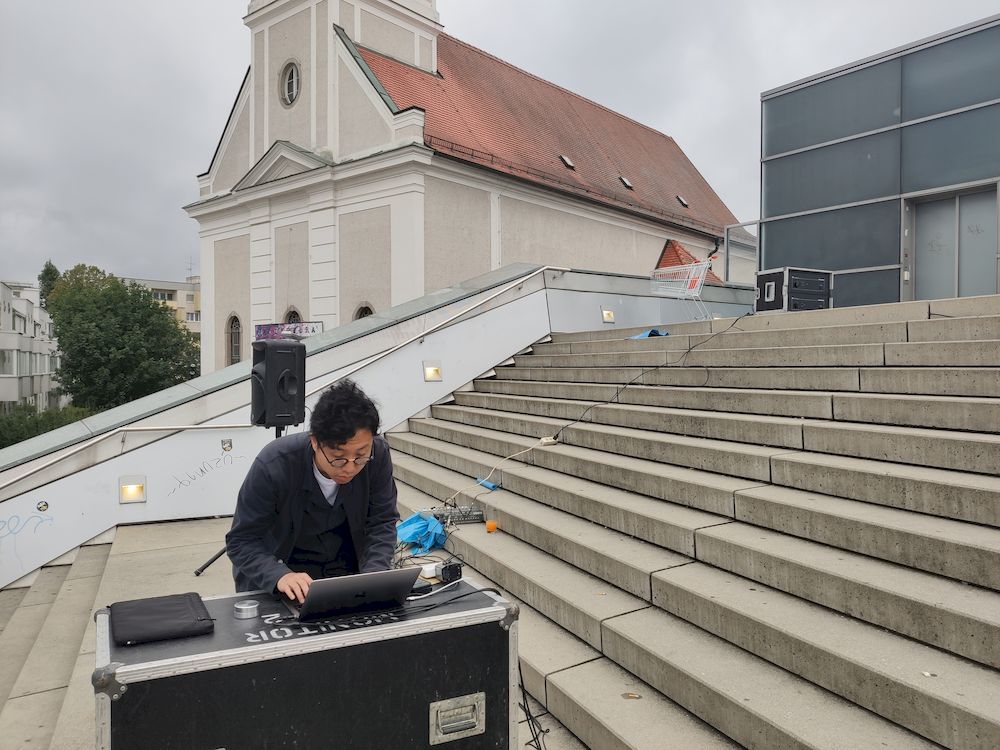
Full program of STWST48x5 at Stadtwerkstatt
Makery will follow up on the 40th anniversary of Ars Electronica with the Golden Nicca awarded to artist Paul Vanouse
